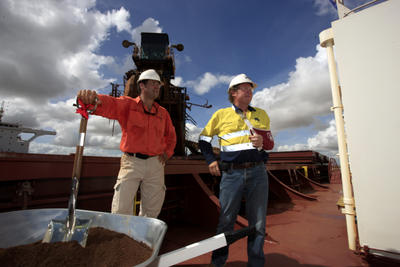Neither China nor Australia has the vision to change the course of its heavy trade dependence on resources. While Australia tries to promote its service exports, for example, China is making a concerted effort to invest in Australian resources so as to integrate its chain of resource supply and manufacture production.
Iron ore has been Australia’s principal export to China for many years. And with China’s rapid industrialisation — the development of its steel industry a notable example — the country now has a serious appetite for the resource. Equally important, coal served as the second-largest Australian export commodity to China in 2009–2010, demonstrating that the robust Chinese economy seems more than capable of intensifying the Australian mining boom — and that Australia’s resources are able to shore up China’s increasing demands.
Copper ore and alumina are also both important trade commodities for the relationship. The surging price of copper ore globally has determined the exploding value of China’s copper ore imports from Australia, while the stability of alumina prices helps safeguard Australian alumina exports to China from market volatility. This comparison underscores the role of price change in China–Australia trade, and that the relationship’s strength is largely dependent on increasing global prices.
Wool has been another important agricultural commodity in terms of Australia’s exported goods to China since the 1970s. But the surge in resource trade has now eclipsed Australia’s wool exports, making this traditionally significant commodity something of a non-event.
With China positioning itself as the world’s second-largest economic power and a global manufacturing workshop, the country has increased its need for raw materials. And the guaranteed supply of resources from Australia, which meets this demand, has resulted in a rapid boom. In fact, Australia’s economy survived the global financial crisis better than most other developed countries, and this can largely be attributed to China’s robust economy and its unprecedented reliance on Australian resources.
But Australia’s resources trade with China has another side.
The surging price of minerals, especially iron ore, has caused economic problems for China. Even though the Chinese steel industry has achieved a great deal, for example, there are potential dangers — one of which is the rapidly increasing price of iron ore currently eroding the industry’s profits.
In senior meetings and speeches, Chinese leaders have consistently called for the need to establish a long-term, stable, healthy relationship between energy demand and resource supply, and to shift from resource trade to resource investment. As early as 2006, a six-point agreement between Chinese Prime Minister Wen Jiabao and Australian Prime Minister John Howard encompassed this appeal. Clean energy, for example, is an important point that both sides are keen to highlight in Chinese investment in Australian resources.
Chinese Vice Premier Li Keqiang has also appealed for both sides to go beyond ‘a simple buyer–seller relationship’ and to ‘innovate new cooperative ways’. This will have far-reaching implications, and shows the Chinese government has every intention to encourage more investment in Australian resources.
Still, the Australian side of the partnership has its own struggles with the surging resource trade. Australia has enjoyed its mining boom and its buoyed resource trade with China. But there is a general sense of malaise concerning Australia’s increased dependence on its trade relationship with China.
Both Australia and China have acknowledged these risks, but chosen to adopt different hedging strategies in response. The Chinese government made the decision to invest in Australian resources in the hope of integrating its steel production and supply chain. In contrast, the Australian government is attempting to expand its service exports to China.
China began its direct investment in Australian resources as early as the 1980s, and this has substantially increased over the last few years. Investment has overwhelmingly concentrated on Australia’s natural resources, including iron ore and liquefied gas. The rationale behind this investment is consistent with its apparent hunger for resources and energy elsewhere around the world; China has also made huge investments in resources throughout Africa, Latin America and the Middle East, in order to secure the stable supply and the steady price of raw materials. For China, it has been helpful to consolidate production and supply chains — and this kind of resource trade and investment can supplement each other, helping to promote trade and investment for both sides. How Australia might increase the role of its service exports to fit in with this long-standing and far-reaching commitment is another question — and is yet to be answered.
Ding Dou is Associate Professor at the School of International Studies, Peking University.

